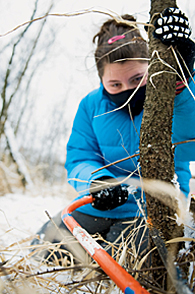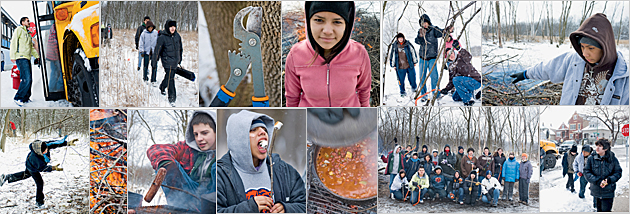sierraclub.org - sierra magazine - november/december 2009 - promise on the prairie


Promise on the Prairie
Working hard outdoors is fun. Even in the heart of a midwest winter.
By M. G. Bertulfo. Photography by Roark Johnson
 Recipe for recovery: A frigid winter's day, a teenager's energy, an invasive buckthorn, a handsaw, and the desire to do the prairie right.
Recipe for recovery: A frigid winter's day, a teenager's energy, an invasive buckthorn, a handsaw, and the desire to do the prairie right.
Chicago in February. It's 9:30 a.m. and a bone-rattling 18 degrees Fahrenheit with wind chill at Theodore Stone Forest Preserve. Snow falls gently at first, then come sheets of damp flakes, fast and steady. I'm huddled in a meadow with a group of Keystoners, teen leaders from the Boys and Girls Clubs of Chicago. Layers of winter caps, hoodies, parkas, and jeans buffer them from the biting wind. We're at a prairie-restoration workday, part of a joint venture between the Sierra Club's Building Bridges to the Outdoors and Inner City Outings programs, which connect kids to nature--even on days when a visit to nature is anything but a day at the beach.
Eric, 13, remembers his first time cutting buckthorn at Ted Stone. He's excited, talking fast: "It's cool because people are cutting down trees instead of spending Saturday playing video games. Right now, we'd be at my house watching TV."
Doug Chien, a field representative for the Sierra Club's Illinois Chapter, gives a friendly welcome, then introduces site steward Barbara Birmingham. She points to a distant mass of tangled branches at the base of some savanna trees: invasive European buckthorn introduced to the region in the 1800s as ornamental hedging and now the bane of Chicago conservationists. Buckthorn has no natural predators, and it's hardy, prolific, and rampant. The plant also hosts the soybean aphid, which poses such a significant threat to Midwestern agriculture that the sale, possession, or planting of buckthorn is prohibited in Illinois.
Birmingham gives the 15 teens their directive for the day. "Get rid of it. Cut and burn it." Music to a restless teen's ears.
We tromp across a bridge spanning the small meanders of a half-frozen creek. Then we hike a quarter mile on a sweeping trail through feathery wheat-colored stems, dried flower heads, and colors at rest--the winter prairie. Stiff grasses shake like rattles in the wind. The landscape is largely dormant but feels very much alive.

An early-morning bus ride from Chicago's General Wood Boys and Girls Club precedes a trudge into Ted Stone Forest Preserve; a morning of sawing, lopping, hoisting, and burning (along with hand warming and good eats by the bonfire); a group portrait; and a triumphant return to the city.
Ted Stone is part of Cook County's Forest Preserve District, roughly 67,000 acres of protected wilderness. Established in 1914, it's one of the oldest and largest county-level forest preserve districts in the United States. Some 13,000 years ago, the slow movement of glaciers left rocky debris, including limestone and dolomite. This geology prepared the ground for the growth of the region's wild prairies--and the scattering of oak and hickory trees found there. Today, the teens encounter luxuriant tallgrass prairie and an ancient dolomite prairie strewn with crumbling, soft-edged rocks.
After a lesson in buckthorn identification and safe cutting techniques, the Keystoners band together in twos and threes and charge into the savanna. It's a day of muscle and youthful energy, sawing, pulling, and tearing. Heavy branches thump onto fresh snow accompanied by spirited cries of "Timber!"
With a saw and loppers, Bianca, 13, and Maria, 14, work on a thorny and resistant gray sapling.
"Aw, this is a pain in the butt," one complains.
"I'm gonna die!" jokes the other.
Finally, the spindly sapling falls in a shaky arc, and the girls squeal. Chien gives them a thumbs-up.
A few feet away, another team wrestles its own buckthorn. Dulce, 18, snips with loppers and struggles to be heard over the whipping wind. "I'm breaking this down so it can burn faster," she says. "It's really hard. The branch has to be thinner than your thumb."
The guys, on the other hand, are very much into their saws. "It's fun!" 16-year-old Fernando says, laughing. "We can't do this at home. We'd get in trouble!"
Alfredo, 19, a Keystone adviser, enthusiastically pumps at the buckthorn he's bracing. "In high school, I was in cabinetmaking, so I'm used to the handsaw." With a chuckle, he adds, "It really is pretty fun."
The night before the Ted Stone trip, nine Keystoners chatted about how rarely they get out into nature: "We don't have much wilderness." "We just have skyscrapers." "Buildings and streets and cars."
They live in Chicago's South Lawndale, a predominantly Latino neighborhood affectionately known as La Villita (the little village), an entry point for Mexican immigrants. Murals on the walls of bustling restaurants and boutiques depict art, music, and cultural pride. But South Lawndale faces tough environmental pressures: 91,000 people are crammed into four square miles, there's a scarcity of green space for kids to play outside, and the neighborhood includes two of the city's oldest and dirtiest coal-fired power plants.
So Keystoners create virtual places to hang out. They're on MySpace, Yahoo Messenger, and Facebook. "If I'm not on the Internet, I'm texting," joked Myra, 15. "That's my life."
Chicago, with its 2.8 million people (part of a metropolitan area of 5.3 million), is fertile ground for programs like Building Bridges. Illinois governor Pat Quinn, a fan of Richard Louv's 2005 book Last Child in the Woods, recently allocated $21 million to parks and open space in the state. He spouts Louvian terms like "leave no child inside" and "nature deficit disorder."
Since 1994, a program called Mighty Acorns has connected roughly 100,000 Chicago-area elementary school students with the outdoors. In 2007, Chicago Wilderness, a consortium of more than 240 organizations, launched the No Child Left Inside initiative.
Building Bridges partnered with the Boys and Girls Clubs of Chicago to take on one of the hardest tasks: reaching underserved urban middle and high school kids. After four years, a simple plan emerged: Introduce them to the wild. Bring them back often. Make it fun. Let them explore in their own ways. Give them opportunities to care for the land.
In 1995, when she became a steward of Ted Stone's 142 acres, says Birmingham, "there was buckthorn as far as the eye could see. Just a little bit in the middle, where it was open, you could see the promise." Wild bergamot. Coneflowers such as brown- and black-eyed Susans. Roundheaded bush clover. She points out the Indian grass and big bluestem, which grow up to eight feet in the preserve's lush prairies. "They're gorgeous," she says. "They're very supple, and they wave in the wind. The roots are twice as long as the plant is tall, and in some cases, three times as long. It's what created the wonderful Midwest farm soil that feeds us."
By 10:15 a.m., the frozen ground is covered with twig debris. Teens troop in with armloads of cut buckthorn that they heave like javelins onto a crackling bonfire. The contrast of dancing fire and frost and the smoky scent of wood are winter pleasures.
Dulce shivers. "Cold!" It's the common refrain mumbled through scarves. "Hold me up," Alfredo says. Friends lift him and hold his feet toward the flames to warm his soles. They crack up, struggling under his weight.
Adult advisers, volunteers, and stewards watch, amused. One circulates, offering extra socks. Meanwhile, an ever vigilant Birmingham keeps the fire organized, directing the teens' javelin tosses so it burns evenly.
Just before noon, the sun peeks through the clouds. With her loppers, Bianca heads deep into a buckthorn thicket. Branches snap, and the tang of fresh wood is in the air. Then it happens. The trail she and other volunteers have cleared opens to a vista: Ted Stone's eastern tallgrass prairie.
Bianca emerges looking incredulous, loppers dangling from her hands. "Whoa! We cut all the way through!" Her smile may be the warmest thing anyone's seen all day.
At lunch, the teens grab steaming bowls of chili and blistered hot dogs and form a semicircle upwind of the bonfire. They rotate to warm first their fronts and then their backsides. "Hey, we're rotisserie chicken!" one jokes.
By the end of lunch, the bonfire has burned down to a circle of white ash. Some teens poke at melted marshmallows and munch the last s'mores. But a few are still revved up. Gustavo, 17, widens the deer trail that now connects the preserve's central and eastern prairies. He's quick, and by this point in the day, he's developed his own system.
I ask him if he's cut buckthorn before. "Once, but I was a little lazy. So this is redemption time." Zip-zip-zip goes his handsaw, and down tumbles one buckthorn tree, two, then a third. He figures he's taken out "about 100." "This is great!" he shouts in a cloud of dust. "Being out in the woods brings out the wilderness in me."
Chien gathers the teens and leads them back to the opening that Bianca and Gustavo helped create. "This is a significant achievement," he says. "We're in a little peninsula of buckthorn, and the kids have broken through!" The teens are tired from the hard work and the unrelenting wind, but the moment has the feel of quiet triumph.
Once impassable buckthorn, their site is now a field of low stubble and a few tall trees that can reemerge as oak-hickory savanna. After four hours of dirty work, with dripping noses and numb toes, they've cleared about an acre. They're winning Ted Stone back from invasives one snip at a time.
M. G. Bertulfo is a Chicago-based writer.
This article was funded by the Sierra Club's Building Bridges to the Outdoors program, whose goal is to give every child in the United States an outdoor experience.
Photos courtesy Roark Johnson.